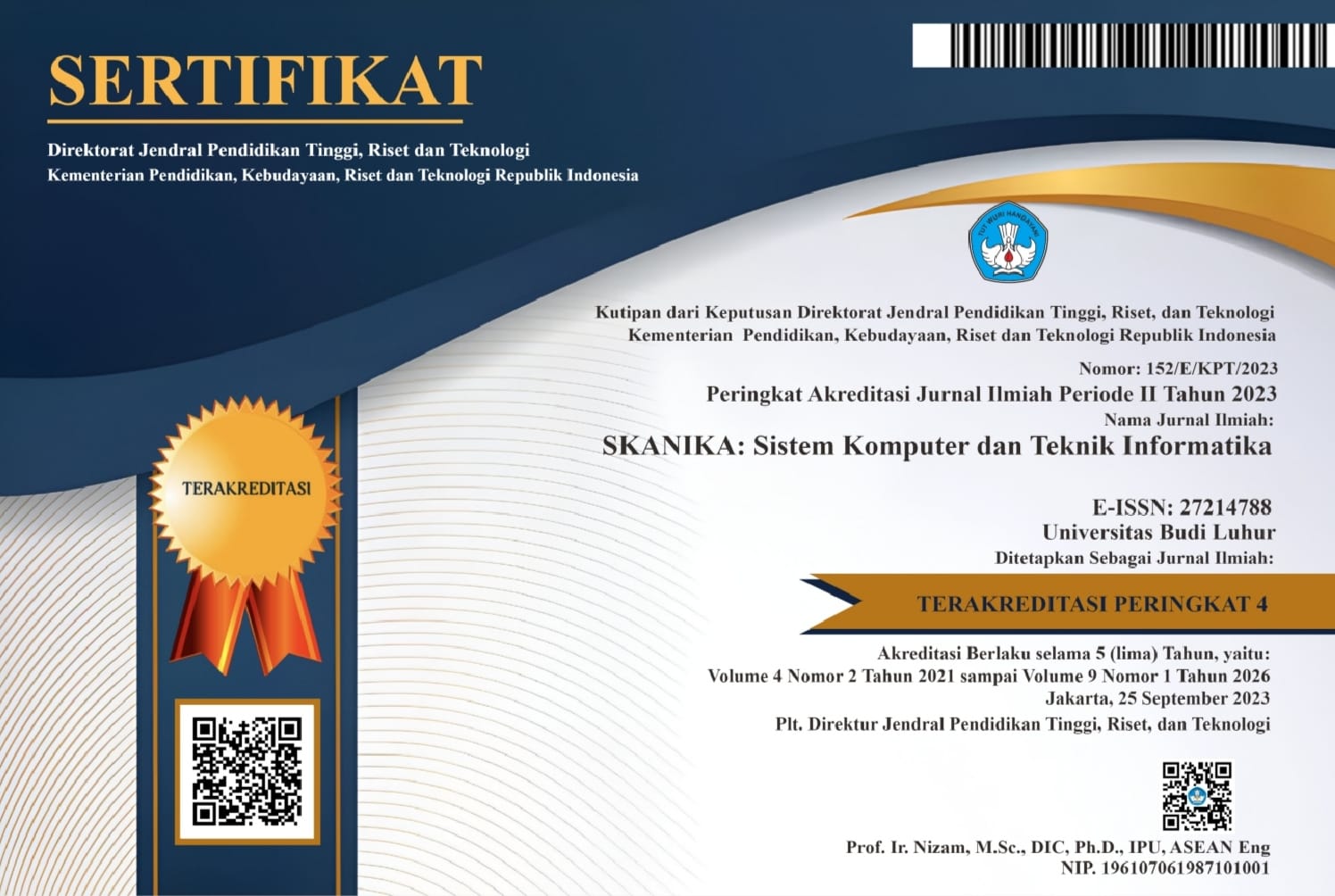OPTIMALISASI FP-GROWTH DENGAN TEKNIK PRUNING UNTUK ANALISIS POLA PEMINJAMAN BUKU UPT PERPUSTAKAAN UNISNU JEPARA
DOI:
https://doi.org/10.36080/skanika.v8i1.3333Keywords:
Association rule, Data analyst, FP- Growth, LibraryAbstract
In the digital age, libraries continue to adapt to provide access to information and knowledge, support education and research, and preserve cultural heritage. The increasing demand for reading materials along with the development of information technology and digital literacy has led to a surge in the amount of data stored on various information provision platforms including libraries. With the sheer volume of data, the challenges of management, analysis and storage have become increasingly complex. Lack of understanding of readers' preferences, inefficiency in book procurement, and difficulty in determining book layout are problems that arise in library management. Therefore, analyzing circulation data is very important, for example using FP- Growth to find patterns of book borrowing. Items that do not meet the criteria but are still included in the calculation process cause the results to be less significant, but pruning which removes items with low frequency of occurrence can improve the accuracy of the analysis. The results of the FP- Growth calculation reveal a relationship between management and economics books with a support of 27%, Confidence 54%, and Lift 956 which means that the two books have a large influence on each other's occurrence. While pruning the number of rules generated is getting smaller, from 26 to 8, but the rules have a strong relationship.
Downloads
References
[2] J. D. Cecilio, G. M. B. Catedrilla, and J. R. Asor, “Application of Apriori Algorithm in One State University’s Library Book Borrower Records for Efficient Library Shelving,” Journal of Software, vol. 18, no. 4, pp. 172–184, 2023.
[3] Y. Wei, et al, “Analysis of Students’ Borrowing Behavior in Local University Library Using Data Mining Technique,” International Journal of Emerging Technology and Advanced Engineering, vol. 12, no. 7, pp. 68–77, 2022.
[4] S. D. Pratiwi, A. Fauzi, and I. G. Prahmana, “Grouping Number of Library Members for Determining the Location of Socialization Using Clustering Method,” Journal of Artificial Intelligence and Engineering Applications, vol. 3, no. 1, pp. 120-127, 2023.
[5] T. Hidayat, Y. Handayani, M. Z. Mufti, “Prediksi Penjualan Produk Pada Sistem Penjualan Point of Sale (POS) Dengan Menerapkan Algoritma Apriori,” SKANIKA: Sistem Komputer dan Teknik Informatika, vol. 6, no. 1, pp. 97–108, 2023.
[6] D. Dwiputra, et al, “Evaluating the Performance of Association Rules in Apriori and FP- Growth Algorithms: Market Basket Analysis to Discover Rules of Item Combinations,” Journal of World Science, vol. 2, no. 8, pp. 1229–1248, 2023.
[7] B. Anwar, A. Ambiyar, and F. Fadhilah, “Application of the FP- Growth Method to Determine Drug Sales Patterns,” Sinkron, vol. 8, no. 1, pp. 405–414, 2023.
[8] Z. Zulham, E. E. Putri, and B. S. Hasugian, “Pattern Analysis of Drug Procurement System With FP- Growth Algorithm,” JOIN (Jurnal Online Informatika), vol. 7, no. 1, pp. 70-79, Jun. 2022.
[9] L. L. VanFC, et.al, “Algoritma FP- Growth dalam Menemukan Pola Peminjaman Buku Perpustakaan,” Jurnal FASILKOM, vol.13, no. 2, pp.159-164, 2023.
[10] H. Cheng, M. Zhang, and J. Q. Shi, “A Survey on Deep Neural Network Pruning-Taxonomy, Comparison, Analysis, and Recommendations,” in IEEE Transactions on Pattern Analysis and Machine Intelligence, vol. 46, no. 12, pp. 10558-10578, Dec. 2024.
[11] K. Purohit, A. R. Parvathgari, and S. Bhattacharya, “A Greedy Hierarchical Approach to Whole-Network Filter-Pruning in CNNs,” Published in Transaction on Machine Learning Research, pp. 1-18, 2024.
[12] V. B. Anwari, Y. Yuliazmi, “Implementasi Algoritma K-Nearest Neighbors pada Analisis Sentimen Masyarakat Terhadap Penerapan Pemberlakuan Pembatasan Kegiatan Masyarakat,” SKANIKA: Sistem Komputer dan Teknik Informatika, vol. 5, no. 1, pp.72-81, 2022.
[13] R. H. Kusumodestoni, et.al, “Clustering of Students Tahfidz Ability Based on K-Means Method,” AIP Conference Proceedings, 2023.
[14] D. Rafly, “Implementasi Data Mining untuk Menentukan Rekomendasi Produk pada Kogu Coffee Shop Malang,” Surabaya, Tel-U Surabaya, 2024.
[15] H. Mulyo and N. A. Maori, “Peningkatan Akurasi Prediksi Pemilihan Program Studi Calon Mahasiswa Baru Melalui Optimasi Algoritma Decision Tree dengan Teknik Pruning dan Ensemble,” Jurnal DISPROTEK, vol. 15, no. 1, pp. 15–25, 2024.
[16] M. H. Huda and M. Syafrullah, “Penerapan Metode Association Rules dengan Algoritme Apriori untuk Mencari Pola Keterkaitan Setiap Item Lewat Perilaku Pelanggan Pada Gavio Boutique Collection Jakarta Pusat.” SKANIKA: Sistem Komputer dan Teknik Informatika, vol. 3, no. 4, pp. 61-66, 2020.
[17] E. Nurarofah, R. Herdiana, and N. D. Nuris, “Penerapan Asosiasi Menggunakan Algoritma FP- Growth pada Pola Transaksi Penjualan Di Toko Roti,” JATI (Jurnal Mahasiswa Teknik Informatika, vol.7, no. 1, pp. 353-359, 2023.
Downloads
Published
How to Cite
Issue
Section
License
Copyright (c) 2025 Akhmad Hossam Manzis, R. Hadapiningradja Kusumodestoni, Harminto Mulyo

This work is licensed under a Creative Commons Attribution-ShareAlike 4.0 International License.
CC BY-SA 4.0
Creative Commons Attribution-ShareAlike 4.0 International
This license requires that reusers give credit to the creator. It allows reusers to distribute, remix, adapt, and build upon the material in any medium or format, even for commercial purposes. If others remix, adapt, or build upon the material, they must license the modified material under identical terms.
BY: Credit must be given to you, the creator.
SA: Adaptations must be shared under the same terms.ng












